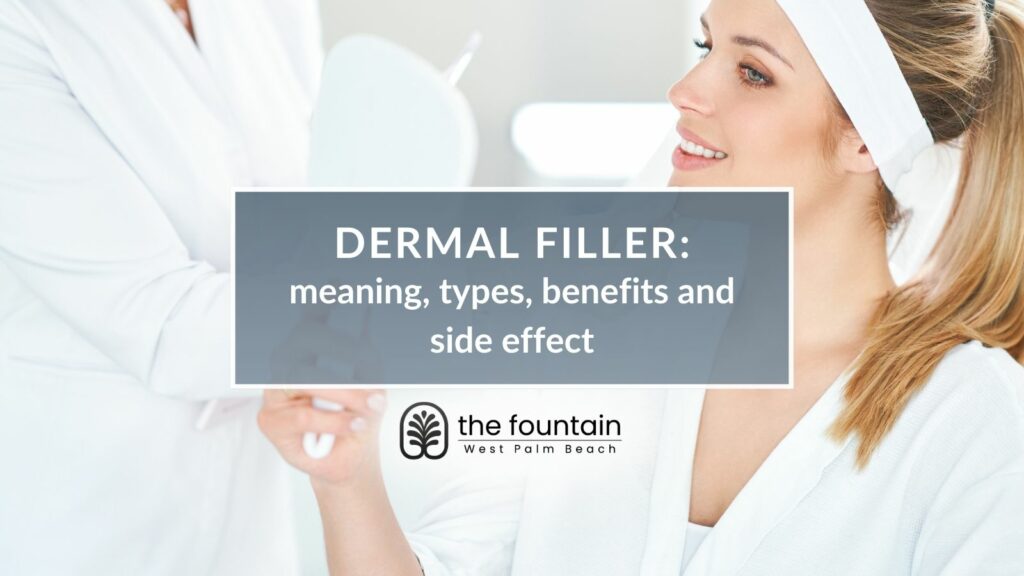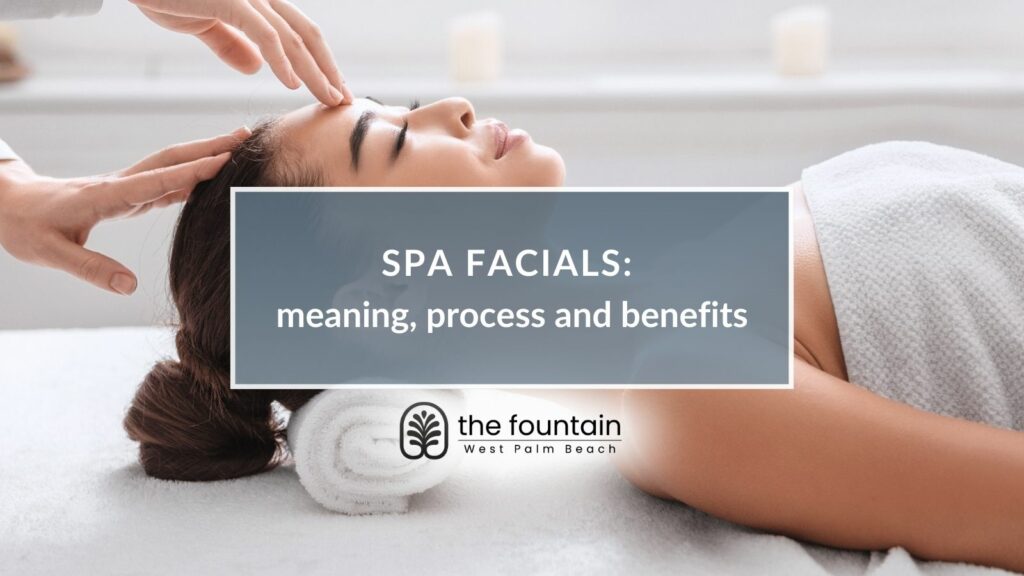Dermal fillers are injectable substances that restore lost volume, smooth lines, and enhance facial contours. They work by replenishing the body’s natural stores of hyaluronic acid, collagen, or other substances that diminish with age, effectively “filling in” lines, wrinkles, and recessed areas.
There are various dermal fillers, each tailored to address specific concerns. Hyaluronic acid fillers are popular for their versatility, while calcium hydroxylapatite and poly-L-lactic acid fillers offer distinct advantages in smoothing wrinkles and restoring volume. Polymethylmethacrylate fillers contain tiny plastic beads and are known for their long-lasting volume enhancement properties.
Dermal fillers offer noninvasive rejuvenation, natural-looking results, quick recovery times, and customizable outcomes. They are a solution for individuals seeking to smooth out wrinkles, restore lost volume, and enhance facial features without invasive surgical procedures.
Despite their benefits, dermal fillers carry potential side effects such as allergic reactions, infection, lumpiness, swelling, and redness. It’s essential for individuals considering these treatments to understand these risks and take necessary precautions to minimize adverse outcomes.
What are Dermal Fillers?
Dermal fillers are injectable substances that restore lost volume, smooth lines, and enhance facial contours, as discussed by Tezel, A. et al. 2007, “The science of hyaluronic acid dermal fillers.” They work by replenishing the body’s natural stores of hyaluronic acid, collagen, or other substances that diminish with age. These fillers are administered beneath the skin’s surface, effectively “filling in” lines, wrinkles, and sunken areas, providing a more youthful and rejuvenated appearance.
People undergo dermal filler treatments to address various cosmetic concerns, such as wrinkles, fine lines, hollow areas, and loss of facial volume. The procedure is typically quick, taking less than half an hour, with minimal downtime. Results are visible immediately after treatment and can last months to years, depending on the type of filler used and the location of the injection. Overall, dermal fillers offer a nonsurgical solution to achieving a more youthful and refreshed look, enhancing facial features, and boosting self-confidence.
What are the Types of Dermal Fillers?
Dermal fillers come in various formulations, each designed to address specific concerns and provide unique benefits. Here’s a detailed overview of the most common types:
1. Hyaluronic Acid Fillers
Hyaluronic acid (HA) fillers are among the most popular and widely used dermal fillers. HA is a natural substance found in the body that helps maintain skin hydration and volume. These fillers are versatile and effective for treating various concerns, including smoothing wrinkles, restoring volume to the cheeks and lips, and enhancing facial contours. Popular examples of HA fillers include Juvéderm, Restylane, and Belotero.
2. Calcium Hydroxylapatite Fillers
Calcium hydroxylapatite (CaHA) fillers are microscopic calcium particles suspended in a gel. This mineral is naturally found in bones and teeth and helps stimulate collagen production in the skin. CaHA fillers are particularly useful for addressing deeper wrinkles and folds and restoring volume to areas of the face that have lost fullness over time. Radiesse and Sculptra are common examples of CaHA fillers.
3. Poly-L-Lactic Acid Fillers
Poly-L-lactic acid (PLLA) fillers stimulate the body’s natural collagen production. They are ideal for improving skin texture, restoring volume to hollow areas, and addressing deeper wrinkles and creases. PLLA fillers offer long-lasting results, with effects lasting two years or more. Sculptra is a well-known example of a PLLA filler.
4. Polymethylmethacrylate Fillers
Polymethylmethacrylate (PMMA) fillers contain tiny plastic beads that remain under the skin after injection. These beads stimulate collagen production and provide long-lasting volume enhancement. PMMA fillers are often used to fill in deep wrinkles and creases and augment facial features. Bellafill is a commonly used PMMA filler.
What are the Benefits of Dermal Fillers?
Dermal fillers offer many advantages for individuals seeking to rejuvenate their appearance or address signs of aging without undergoing invasive surgical procedures. These injectable treatments provide a non-invasive solution for smoothing out wrinkles, restoring lost volume, and enhancing facial contours. With natural-looking results, quick recovery times, and long-lasting effects, dermal fillers have become popular among those looking to achieve a refreshed and youthful appearance.
1. Smoothing Out Wrinkles and Fine Lines
One of the primary benefits of dermal fillers is their ability to reduce the appearance of wrinkles and fine lines. According to Akinbiyi, T. et al. 2020, “Better Results in Facial Rejuvenation with Fillers,” by injecting fillers into areas of the face that have lost volume, a skilled provider plumps up the skin and smooths wrinkles, giving the face a more youthful, refreshed appearance. These fillers effectively fill in lines and creases, restoring a smoother texture to the skin and diminishing the signs of aging.
2. Restoring Volume to the Face
Our face loses volume as we age, leading to a hollowed-out, sunken appearance. Dermal fillers restore volume to areas of the face that have lost fullness over time, such as the cheeks, temples, and jawline. By replenishing lost volume, fillers rejuvenate the face, restoring a youthful contour and minimizing the appearance of sagging or drooping skin.
3. Enhancing Facial Features
Dermal fillers enhance certain facial features. For example, fillers often create more defined cheekbones, enhance the lips, or plump up the chin for a more balanced facial profile. By strategically injecting fillers into specific areas of the face, a skilled provider enhances the overall symmetry and harmony of the facial features, achieving a more aesthetically pleasing appearance.
4. Minimal Downtime
Unlike invasive cosmetic procedures such as facelifts or brow lifts, dermal fillers require minimal downtime. Most patients return to their regular routines immediately after treatment, making them a convenient option for those with busy schedules. While minor swelling or bruising may occur, it is usually temporary and easily concealed with makeup. This minimal downtime makes dermal fillers attractive for individuals looking to refresh their appearance without disrupting their daily lives.
5. Customizable Results
Patients achieve highly customizable results with various dermal fillers with unique characteristics and uses. A skilled provider tailors the treatment to the patient’s needs and goals, ensuring natural-looking results that enhance their distinctive features. Whether seeking subtle enhancement or more dramatic rejuvenation, patients often work closely with their providers to achieve their desired outcomes.
What are the Side Effects of Dermal Fillers?
While dermal fillers offer numerous benefits in enhancing facial appearance and combating signs of aging, there are some potential risks and side effects associated with these treatments, as mentioned in Funt, D. et al. 2013, “Dermal fillers in aesthetics: an overview of adverse events and treatment approaches.” Understanding these considerations can help individuals make informed decisions about cosmetic procedures and minimize adverse outcomes. Here are the various side effects and risks associated with dermal fillers:
1. Allergic Reactions
Some individuals experience allergic reactions to the filler material used in dermal filler injections. Symptoms of an allergic reaction include redness, itching, and swelling at the injection site. While allergic reactions are rare, discussing any known allergies with your healthcare provider before undergoing treatment is crucial.
2. Infection
There is a small risk of infection associated with dermal filler injections, particularly at the injection site. To mitigate this risk, choosing a qualified provider who adheres to strict hygiene protocols during the procedure is essential. Additionally, following proper aftercare instructions also help minimize the likelihood of infection.
3. Lumpiness
If an excessive amount of filler is injected or is not evenly distributed beneath the skin’s surface, it will likely result in a lumpy or uneven appearance. This outcome underscores the importance of selecting a skilled and experienced provider who precisely administers the filler to achieve natural-looking results.
4. Swelling and Bruising
Following dermal filler injections, some degree of swelling and bruising at the injection sites is common. While these side effects are typically mild and temporary, they can sometimes persist for several days or longer. Applying cold compresses and avoiding strenuous activities help alleviate swelling and bruising during recovery.
5. Nodules or Bumps
In rare instances, dermal fillers form nodules or bumps under the skin, resulting in an uneven texture or contour. While these occurrences are uncommon, your provider usually corrects them with additional treatment or adjustments.
6. Redness and Tenderness
Temporary redness and tenderness at the injection sites are common side effects of dermal filler treatment. These symptoms typically subside within a day or two but may persist for longer periods in some individuals. Gentle skincare and avoiding exposure to sunlight can help alleviate redness and tenderness during recovery.
How long do dermal fillers last?
Dermal fillers last from around 6 months to 2 years, depending on the type of filler used and individual factors. Generally, hyaluronic acid fillers last around 6 to 18 months, while calcium hydroxylapatite and poly-L-lactic acid fillers can last up to 2 years or more.
How does laser skin resurfacing complement dermal filler treatments?
Laser skin resurfacing can enhance the results of dermal fillers by improving the texture and quality of the skin. While fillers address volume loss and deep wrinkles, laser resurfacing improves superficial skin concerns such as fine lines, pigmentation, and overall skin tone. To understand more about how these treatments can be combined for optimal aesthetic results, refer to our detailed article on laser skin resurfacing.
How does dermal filler treatment differ from Botox?
While both dermal fillers and Botox are injectable treatments for wrinkles, they work differently. Dermal fillers “fill” or add volume to the treated areas, whereas Botox relaxes the muscles that cause wrinkles. They are often used in conjunction to address both volume loss and muscle activity-related wrinkles.
Can dermal fillers be dissolved if needed?
Hyaluronic acid fillers can be dissolved using an enzyme called hyaluronidase. This enzyme breaks down the hyaluronic acid filler, allowing for rapid reversal of the treatment if necessary.
Are dermal fillers painful?
No, the discomfort during dermal filler injections is usually minimal and well-tolerated. Most fillers contain a local anesthetic to numb the treatment area, and providers can also use topical numbing creams for additional comfort.
Can dermal fillers be combined with other cosmetic procedures?
Dermal fillers can complement cosmetic procedures such as Botox injections, chemical peels, and laser treatments. Combining treatments can enhance overall results and address multiple aesthetic concerns simultaneously.
Are dermal fillers suitable for everyone?
While dermal fillers are generally safe for most individuals, they may not be suitable for pregnant or breastfeeding women, individuals with certain medical conditions, or those with a history of severe allergies. It’s essential to consult a qualified provider to determine candidacy and discuss potential risks.





